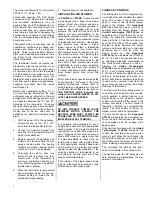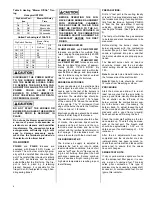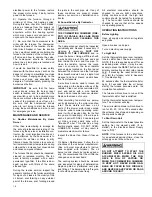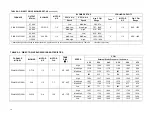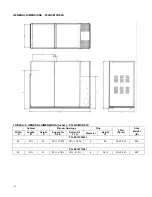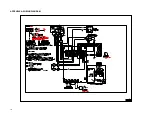
8
Table 5: Heating “Blower Off/On” Tim-
ing
Honeywell ST9103
Dip Switch Posi-
tion
Blower Off Delay
Time
1 2
On On
60
seconds
On Off
90
seconds
Off On
120
seconds
Off Off
150
seconds
United Technologies 1158-120
Dip Switch Position
Blower Delay
Times
1 2 3 4 On
Sec.
Off
Min.
Off Off
30
On Off
60
Off On
90
On On
120
Off
Off
2
On
Off
3
Off
On
4
On
On
6
DISCONNECT THE POWER SUPPLY
TO THE FURNACE BEFORE OPEN-
ING THE BLOWER ACCESS DOOR
TO SERVICE THE AIR FILTER, FAN
AND MOTOR. FAILURE TO SHUT OFF
POWER COULD ALLOW THE
BLOWER TO START UNEXPECT-
EDLY, CREATING A RISK OF DEATH
OR PERSONAL INJURY.
DO NOT START THE BURNER OR
BLOWER FAN UNLESS THE BLOWER
ACCESS DOOR IS SECURELY IN
PLACE.
Do not use the blower speed wires as
a source of power to accessories as
electronic air cleaners and humidifier
transformers. The unused motor taps
auto-generate sufficiently high volt-
ages to damage accessory equip-
ment. Use the terminals provided on
the electronic fan timer board
OIL BURNER
P3HMX
and
P3LBX
furnaces are
equipped with Beckett AFG Series oil
burners. The oil burner must align prop-
erly with the cerafelt fiber chamber (fire-
pot). The cerafelt fiber chamber is initially
quite soft, but hardens and becomes
quite brittle after the first firing. The fire-
pot is held in place by a retaining
bracket; however, it is possible for the
firepot to shift if subjected to rough han-
dling during transit.
BEFORE OPERATING THE FUR-
NACE CHECK BURNER ALIGNMENT
WITH COMBUSTION CHAMBER.
THE END CONE OF THE AIR TUBE
MUST BE CENTRED TO THE AC-
COMODATING RING PROVIDED IN
THE DESIGN OF THE COMBUSTION
CHAMBER. ADJUST ALIGNMENT AS
NECESSARY BEFORE THE FIRST
FIRING.
OIL BURNER NOZZLES
P3HMX12F08001
and
P3LBX12F08001
furnaces are certified for multiple firing
rates, ranging from approximately 60,000
to 80,000 BTU/hr. The
P3HMX14F10001
,
P3HMX20F12001
and
P3LBX14F12001
furnaces are certi-
fied for multiple firing rates of approxi-
mately 85,000 115,000 BTU/hr. By
changing the oil burner nozzle within the
specific Model Range, and temperature
rise, the furnace may be fired at an ideal
rate for a wide range of structures.
BURNER ELECTRODES
Correct positioning of the electrode tips
with respect to each other, to the fuel oil
nozzle, and to the rest of the burners is
essential for smooth light ups and proper
operation. The electrode tips should be
adjusted to a gap of 5/32”, 1/16” ahead
of the nozzle, 5/16” above the centerline
of the nozzle. The “Z” dimension (front
edge of the burner head to the front face
of the nozzle is 1-1/8 inches.
Electrode positioning should be checked
before the first firing of the furnace.
The electrode porcelains should be free
of cracks, the electrode tips should be
tapered and free of burrs, and the con-
tact rods must be clean and be in firm
contact with the ignition transformer con-
tact springs. The electrodes must not
come into contact with the burner head.
OIL BURNER SET-UP
The burner air supply is adjusted to
maintain the
fuel to air
ratio
to obtain
ideal combustion conditions. A lack of air
causes "soft" and "sooty" flames, result-
ing in soot build-up throughout the heat
exchanger passages. Excess combus-
tion air causes a bright roaring fire and
high stack temperatures resulting in poor
fuel efficiency.
PREPARATIONS:
Drill a ¼” test port in the venting, ideally
at least 2 flue pipe diameters away from
the furnace breeching, if venting horizon-
tally from the furnace, (typically P3LBX)
or from the flue pipe elbow if venting
vertically (typically P3HMX) before
reaching the furnace. (See Figures 4 and
5).
The test port will allow flue gas samples
to be taken and stack temperatures to be
measured.
Before starting the burner, check the
burner alignment with the combustion
chamber (fire pot), check that the correct
nozzle is tightened into place, and that
the burner electrodes are properly posi-
tioned.
The Beckett burner bulk air band is
should be closed, and the air shutter
initial setting should be approximately
7.00.
Note A
: Locate hole at least 6 inches on
the furnace side of the draft control.
Note B
: Ideally, hole should be at least
12 inches from breeching or elbow.
PROCEDURE:
Start the burner and allow it to run at
least ten minutes. Set the air shutter to
give a good flame visually. Manipulating
the air shutter on the left side of the
burner controls the combustion air sup-
ply to the burner, and, if necessary, the
bulk air band. To adjust, loosen the bolt
on the movable shutter. Move the shutter
gradually until a good flame (visually)
has been achieved. Re-snug the bolt.
Check the initial draft setting as the fur-
nace warms up. The draft may be meas-
ured at the test port. The breech draft
should be approximately - 0.05” w.c. to
obtain an over fire draft reading of - 0.02
inches w.c.
After the air adjustments have been
completed, and the air shutter or air ad-
justment plate has been secured, re-
check the over fire draft and take another
smoke test to ensure that the values
have not changed.
SMOKE TEST NOTE
:
If oily or yellow smoke spots are found
on the smoke test filter paper, it is usu-
ally a sign of unburned fuel. This indi-
cates poor combustion. This type of
problem may be caused by excess draft,
excess air, or contaminated fuel. Do not
ignore this indicator.
Содержание P3HMX12F08001
Страница 16: ...16 APPENDIX A WIRING DIAGRAM ...







